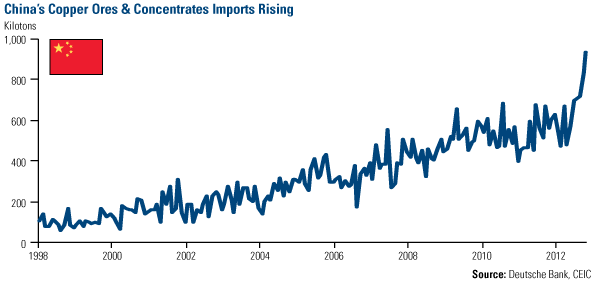Energy and Natural Resources Market Radar (January 28, 2013)

Strengths
• Commodity-hungry China showed more signs of a strengthening economy this week with the HSBC flash PMI for January rising further to 51.9 in January from 51.5 in December which suggests growth momentum continues to improve in the first quarter.
• Energy stocks led the S&P 500 to multi-year highs this week with a gain of nearly 2.5 percent as crude oil gained about 50 cents on the week to finish at $96 per barrel for WTI.
• Palladium closed the week at a 15-month high price of $740 per ounce on continued mine disruptions in South Africa.
Weaknesses
• Bloomberg reported that Vale has suspended construction at its Rio Colorado potash project in Argentina. The Rio Colorado project was expected to represent approximately 4.3 million tons of annual production at full run-rates, with our forecasts assuming production starting up in 2016. Capex was estimated at $5.9 billion with approximately $1.6 billion already invested. Wednesday's news follows previous reports that Vale had officially postponed its $3 billion potash project in Saskatchwan, Canada (Kronau) and separately was looking for potential investment partners in the Rio Colorado project.
• This week saw the release of December’s global crude steel and pig iron production data by Worldsteel. The data show continued weakness in ex-China output at the end of 2012, rounding off what was a difficult year for the global industry. 2012 saw global steel output rise 1.2 percent year-over-year, although after stripping out the reported 3.1 percent growth in Chinese output, ex-China production fell 0.4 percent, with most of the weakness coming in the second half of the year.
Opportunities
• CNBC.com wrote that the slowdown in the world's largest economies last year, particularly in China, led to warnings that the end of the commodities super-cycle was near, as prices of key resources plummeted. However, a flood of government stimulus unveiled in recent months has reversed that trend, prompting one expert to say the commodities bull run that began in 2002, is here to stay. "(The super cycle) is still intact. The combination of the economic recovery, especially with China powering ahead, and continuing support from central banks…It's going to be a good year for commodities," Eugen Weinberg, global head of commodities research at Commerzbank told CNBC on Friday, pointing to the Bank of Japan's commitment to open-ended easing this week.
• According to a new study by IHS, in the United States alone, the direct, indirect and induced effects of the surge in nonconventional oil and gas extraction have already added 1.7 million jobs (with 3 million expected by 2020) and $62 billion to federal and state government coffers in 2012 (with $111 billion expected by 2020). For the first time in many decades, a number of large global chemicals companies have announced plans to build or expand facilities in North America for exports—capital expenditures totaling around $95 billion in the next decade, focused primarily on ethylene production.
• The Russian central bank will continue to buy gold as it seeks to diversify its foreign reserves away from paper assets it views as risky, First Deputy Chairman Alexei Ulyukayev said on Thursday. The bank has also been a bullion buyer and the share of gold in its reserves is approaching a medium-term target of 10 percent.
Threats
• The global copper market faces a surplus of the metal that may push down prices toward the end of the year, according to Codelco CEO Thomas Keller. “Maybe there will be a certain element of downward pressure, albeit very slight, toward the end of the year when there will be a small surplus,” Keller said.
• Bloomberg news reported that Barclays commodity traders believe iron ore will almost erase the past two months’ rally and fall 19 percent in the second quarter as weather stops disrupting supply and Chinese restocking ends.
• According to media reports Farc rebels in Colombia blew up two southern oil pipelines, including the Transandino pipeline (a 48,000 barrels-per-day pipeline from Putumayo to the Pacific Coast) after a two month cease-fire ended on January 20 with no extension.











